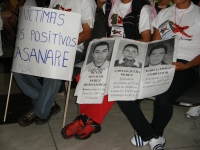By R. Renee Yaworsky
Impunity Watch Reporter, South America
QUITO, Ecuador—Locked in a lawsuit over their allegedly environmentally unsound oil practices, Chevron Corp. has now turned up the heat against their legal opponents. Chevron has subpoenaed and published numerous documents privately exchanged between members of the plaintiffs’ legal team. The documents include emails and letters, and even a diary. Also released are cut scenes from a documentary about the case.
Outtakes being used from the documentary “Crude” include a scene of plaintiffs’ attorney Steven Donziger saying that Ecuadoran judges respond better to fear than the law. Donziger goes on to say that any judge ruling against the plaintiffs might not be killed by angry Ecuadorans, but “[the judge will think] he will be [killed] . . . which is just as good.”
Although Chevron thinks that their line of documents and film scenes add up to fraud and misconduct by the plaintiffs’ legal team, the team’s spokesperson explained: “The comments were all born out of a frustration with Chevron’s efforts to undermine the trial in Ecuador. The real fraud in this case is Chevron’s intentional contamination of the rain forest and its efforts, now on display in the United States, to cover it up.”
In 2003, a class action lawsuit was brought against Texaco, which was acquired by Chevron in 2001. The lawsuit was brought in Ecuador by claimants alleging that the company contaminated the land where it was performing oil operations. The claimants believed that the environmental pollution increased cancer rates and other medical issues in those who lived in the area. After judicial inspections of the region, an independent expert in 2008 recommended that the court demand Chevron pay $27 billion as compensation for their activities.
The initial judge in the case recused himself after allegations were made about judicial misconduct; the current judge has intimated that a verdict may be expected sometime this year.
This present chapter in the lawsuit is preceded by a history dating back to a similar lawsuit filed against Texaco in 1993. Texaco drilled for oil in an Ecuadoran rain forest from 1964 until 1992, unloading a petroleum and water mix into pits near the oil wells.
For more information, please see:
Business & Human Rights Resource Centre-Case profile: Texaco/Chevron lawsuits (re Ecuador)-12 January 2011
Westlaw News & Insight-Film outtakes steal stage in Chevron Ecuador case-11 January 2011
San Francisco Chronicle-Chevron tries to use foe’s words against them-29 December 2010


